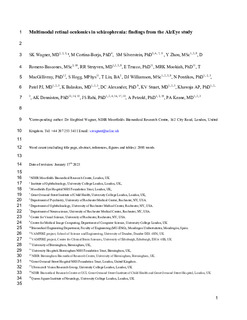
Izenburua
Association Between Retinal Features From Multimodal Imaging and SchizophreniaEgilea
Egilea (beste erakunde batekoa)
Argitalpen data
2023Beste erakundeak
NIHR Moorfields Biomedical Research CentreUniversity College London
Moorfields Eye Hospital NHS Foundation Trust
University of Rochester
University of Dundee
University of Edinburgh
University Hospitals Birmingham NHS Foundation Trust
University of Birmingham
Great Ormond Street Hospital for Children NHS Foundation Trust
NIHR Biomedical Research Centre
Bertsioa
PostprintaDokumentu-mota
ArtikuluaArtikuluaHizkuntza
IngelesaEskubideak
© 2023 American Medical AssociationSarbidea
Sarbide irekiaArgitaratzailearen bertsioa
http://doi.org/10.1001/jamapsychiatry.2023.0171Non argitaratua
JAMA Psychiatry Argitaratzailea
JAMA NetworkGako-hitzak
Psychiatry and Behavioral Health
Schizophrenia Spectrum and Other Psychotic Disorders
Ophthalmology
Retinal Disorders ... [+]
Schizophrenia Spectrum and Other Psychotic Disorders
Ophthalmology
Retinal Disorders ... [+]
Psychiatry and Behavioral Health
Schizophrenia Spectrum and Other Psychotic Disorders
Ophthalmology
Retinal Disorders
Radiology
Ophthalmic Imaging
ODS 3 Salud y bienestar [-]
Schizophrenia Spectrum and Other Psychotic Disorders
Ophthalmology
Retinal Disorders
Radiology
Ophthalmic Imaging
ODS 3 Salud y bienestar [-]
Laburpena
Importance. The potential association of schizophrenia with distinct retinal changes is of clinical interest but has been challenging to investigate because of a lack of sufficiently large and detaile ... [+]
Importance. The potential association of schizophrenia with distinct retinal changes is of clinical interest but has been challenging to investigate because of a lack of sufficiently large and detailed cohorts.
Objective. To investigate the association between retinal biomarkers from multimodal imaging (oculomics) and schizophrenia in a large real-world population.
Design, Setting, and Participants This cross-sectional analysis used data from a retrospective cohort of 154 830 patients 40 years and older from the AlzEye study, which linked ophthalmic data with hospital admission data across England. Patients attended Moorfields Eye Hospital, a secondary care ophthalmic hospital with a principal central site, 4 district hubs, and 5 satellite clinics in and around London, United Kingdom, and had retinal imaging during the study period (January 2008 and April 2018). Data were analyzed from January 2022 to July 2022.
Main Outcomes and Measures. Retinovascular and optic nerve indices were computed from color fundus photography. Macular retinal nerve fiber layer (RNFL) and ganglion cell–inner plexiform layer (mGC-IPL) thicknesses were extracted from optical coherence tomography. Linear mixed-effects models were used to examine the association between schizophrenia and retinal biomarkers.
Results. A total of 485 individuals (747 eyes) with schizophrenia (mean [SD] age, 64.9 years [12.2]; 258 [53.2%] female) and 100 931 individuals (165 400 eyes) without schizophrenia (mean age, 65.9 years [13.7]; 53 253 [52.8%] female) were included after images underwent quality control and potentially confounding conditions were excluded. Individuals with schizophrenia were more likely to have hypertension (407 [83.9%] vs 49 971 [48.0%]) and diabetes (364 [75.1%] vs 28 762 [27.6%]). The schizophrenia group had thinner mGC-IPL (−4.05 μm, 95% CI, −5.40 to −2.69; P = 5.4 × 10−9), which persisted when investigating only patients without diabetes (−3.99 μm; 95% CI, −6.67 to −1.30; P = .004) or just those 55 years and younger (−2.90 μm; 95% CI, −5.55 to −0.24; P = .03). On adjusted analysis, retinal fractal dimension among vascular variables was reduced in individuals with schizophrenia (−0.14 units; 95% CI, −0.22 to −0.05; P = .001), although this was not present when excluding patients with diabetes.
Conclusions and Relevance. In this study, patients with schizophrenia had measurable differences in neural and vascular integrity of the retina. Differences in retinal vasculature were mostly secondary to the higher prevalence of diabetes and hypertension in patients with schizophrenia. The role of retinal features as adjunct outcomes in patients with schizophrenia warrants further investigation. [-]




















